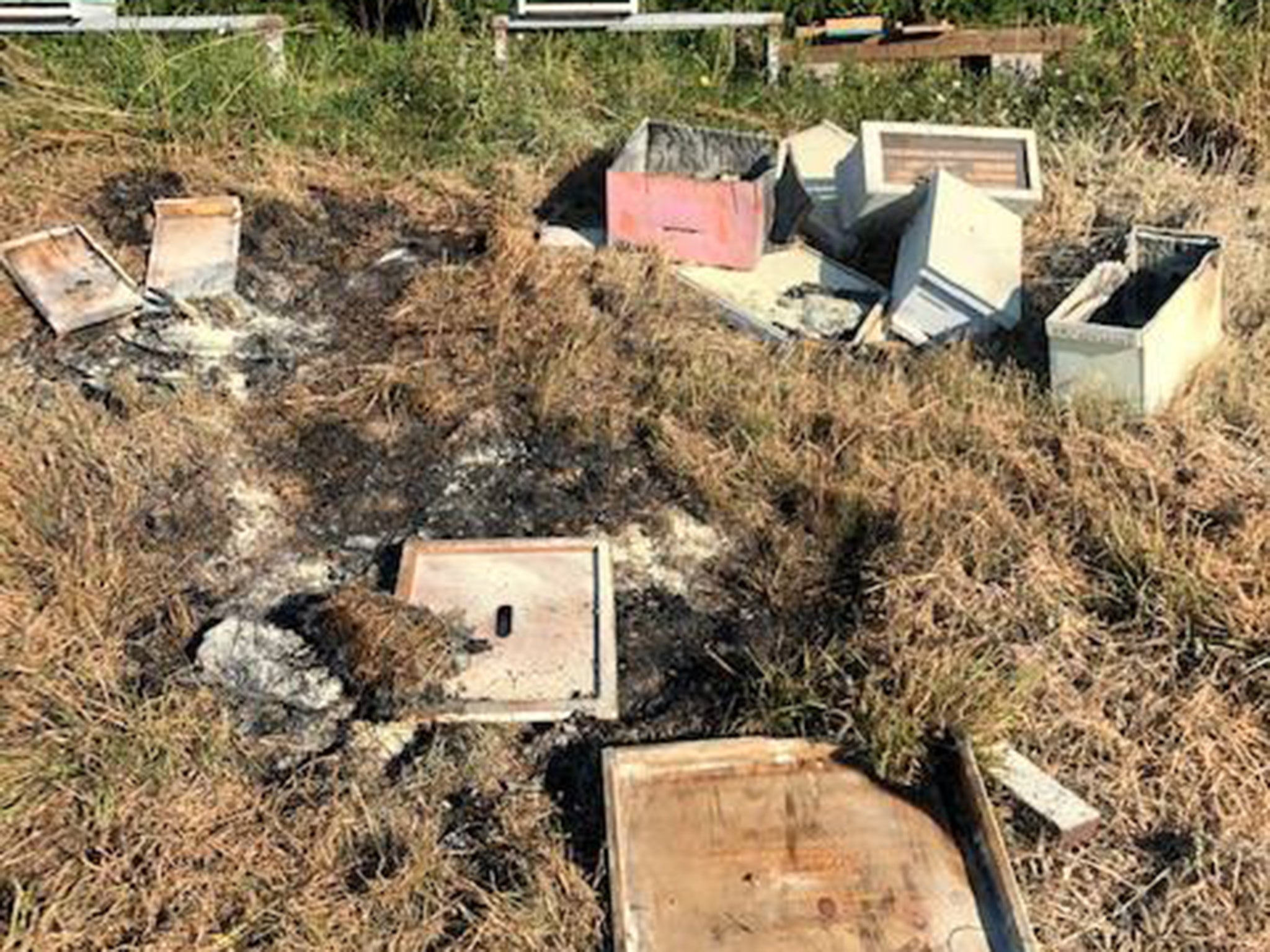More than half a million honey bees killed after attacker sets hives on fire
Remaining bees in ‘panic mode’ with colony scattered after queen killed

More than half a million bees have been killed after someone set their hives alight in a rural area of south east Texas.
Most of the 20 hives, once thriving with bees that had nurtured mature colonies, were incinerated, but some had been tossed into a pond or toppled over.
About 600,000 bees were dead after the attack on Saturday, according to the Brazoria County Beekeepers Association.
“I was just in shock that somebody would actually do that,” said Steven Brackman, the president of the organisation, whose 300 beekeepers make up one of 50 such groups in the state.
“That’s what we don’t understand. Three years they were there, and most neighbours know about it.”
He said that vandals had occasionally struck before, but a living hive had never been set on fire or drowned. “You can’t recover,” he said.
In Brazoria, a coastal county south of Houston of about 350,000 people, the bee slaughter has captivated residents and mystified fire officials and deputies.
As far as crimes go, it was not all that serious – there were no deaths or injuries, not even superficial burns from the deputy’s firefighting efforts, police spokesperson Lieutenant Varon Snelgrove said.
No surveillance cameras were at the scene, near a farm on the outskirts of the city of Alvin, and the authorities do not know if there was a single culprit or more.
“You could look at it from two different avenues,” Mr Snelgrove said, speaking before a meeting on Wednesday with investigators.
“Was someone just creating mischief for no other reason than to destroy something?” he asked. “Or did someone have an ax to grind with someone? Could it be another beekeeper? There are a lot of different avenues that it could take.”
The drowning and fire damaged the hives in the middle of a crucial time of year. In recent weeks, the blooming of plants has set off the honey flow, and queen bees are laying thousands of eggs a day, Mr Brackman said.
The honey bee, which is the species of bee that has been the dominant pollinator for decades, is threatened by pesticides, poor nutrition and other causes.
In 2017, US beekeepers lost an estimated 40 per cent of their managed honey bee colonies, according to the Bee Informed Partnership, a non-profit that advises beekeepers.
Pesticides and genetically modified plants shorten the bees’ life span, Mr Brackman said. And fewer nutrients are brought back to the hive for the rest of the brood, which is now fed nectar and pollen infused with the chemicals.
In south east Texas, the warm climate attracts beekeeping enthusiasts from around the US, who bring their hives to the state to escape cold winters.
The bees that were killed on Saturday belonged to four owners, who were raising them as a hobby, as part of education programmes, or to sell honey and its related products at a market hosted by a nearby farm. They installed their hives on wooden stands on the grassy 3-acre patch of land because they did not have space on their own property.
Eight hives – each with about 60,000 bees – that were destroyed belonged to Sam Degelia, 69, a retired welder who supplements his income by selling honey at the farmers’ market for about $8 a pound. He lost an estimated 1,000 pounds’ worth of honey from his Buckfast bees, which are a species of honey bee.
“If you can get through the multiplication, that’s quite a bit,” he said in an interview.
The sheriff’s office called him around 2am on Saturday to tell him about the fire. Mr Degelia went out to the land when it was still dark, using a flashlight until it became impossibly swarmed by stray, homeless bees.
“Boxes burned, grass was burned,” he said. “A really big loss.”
“I don’t want to say it’s like losing a kid, but you put all your hard work and pride in it, and somebody kicks the bucket from under you,” he said. “First there is the shock of losing the bees, and then you say, ‘Well, there goes my honey flow.’”
The remnants of four hive structures have been salvaged. But the future of their societies is in question because the queens and their eggs have not been detected in them, Mr Brackman said.
“The pheromones are gone and the colony is scattered,” he said. “When she is killed off, the colony goes into panic mode. They know without the queen, they are going to die.”
He said that members of the group at the beekeeping spot had not had previous complaints about their activities. The nearest residence is about 50 yards away, he said.
“Far enough away that they would not be bothered by any bees,” he said. “You could stand there by the fence, and a bee might land on you, maybe trying to lick the sweat off your face.”
Only when you interfere with the hive does trouble come in a swarm of hundreds. “Then they sting in defence of the colony,” he said.
New York Times
Join our commenting forum
Join thought-provoking conversations, follow other Independent readers and see their replies
Comments